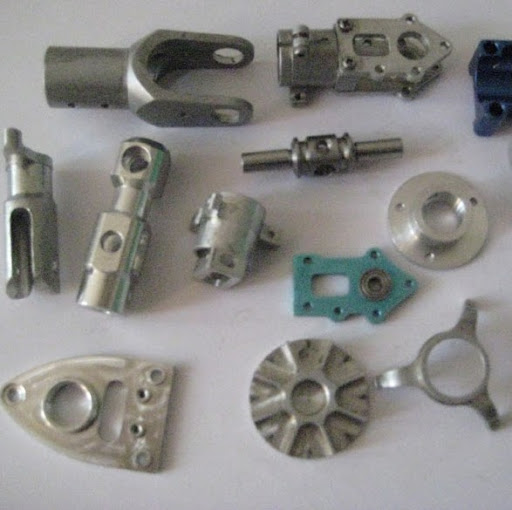Li Chuan Fang
age ~56
from Sacramento, CA
- Also known as:
-
- Li C Fang
- Lichuan C Fang
- Li-Chuan Fang
- Lichuan Chuan Fangli
- Chuan Fang Li
- Chuan Fang Lichuan
- Lichuan Lee
Li Fang Phones & Addresses
- Sacramento, CA
- Gilroy, CA
- San Jose, CA
- San Bernardino, CA
- Saint Louis, MO
Wikipedia References

Li Fang
Work:
Position:
Prime Minister
Education:
Specialty:
Compiler
Us Patents
-
Method And Constructs For Inhibiting Protein Expression In Bacteria
view source -
US Patent:6686174, Feb 3, 2004
-
Filed:Apr 16, 1999
-
Appl. No.:09/293427
-
Inventors:Li Fang - Burlingame CA
Masanori Mitta - Kyoto, JP
Masayori Inouye - Piscataway NJ -
Assignee:The University of Medicine and Dentistry of New Jersey - New Brunswick NJ
-
International Classification:C07H 2102
-
US Classification:435 691, 4352523, 43525233, 4353201, 435471, 536 231, 536 241, 536 245
-
Abstract:A method of inhibiting the translation of bacterial mRNA is disclosed. The method comprises overexpressing in a bacterium an mRNA which contains a sequence which is complementary to the anti-downstream box region of the 16S rRNA. RNA and DNA constructs for the overexpression of the mRNA of the invention are disclosed. Further, there are disclosed isolated DNA constructs that direct the prolonged expression of a heterologous gene in a cold-shocked bacterium at reduced temperature. The construct can comprise a promoter region of a cold-shocked inducible gene. The replication vehicle comprising such DNA constructs and a method for overexpressing a heterologous gene in a bacterium transformed with such a replication vehicle are also disclosed.
-
Adaptive Network Traffic Compression Mechanism Including Dynamic Selection Of Compression Algorithms
view source -
US Patent:7420992, Sep 2, 2008
-
Filed:Mar 17, 2005
-
Appl. No.:11/082638
-
Inventors:Li Fang - San Jose CA, US
Mary Louise Laier - Cupertino CA, US -
Assignee:Packeteer, Inc. - Cupertino CA
-
International Classification:H04J 3/18
-
US Classification:370477, 370521, 375240, 709247
-
Abstract:An adaptive compression mechanism that dynamically selects compression algorithms applied to network application traffic to improve performance. One implementation includes an arbitration scheme that reduces the impact on computing resources required to analyze different compression algorithms for different network applications. The adaptive compression functionality of the present invention can be integrated into network application traffic management or acceleration systems.
-
Method And System For Dynamically Capturing Flow Traffic Data
view source -
US Patent:7580356, Aug 25, 2009
-
Filed:Mar 16, 2006
-
Appl. No.:11/377786
-
Inventors:Sanjeev K. Mishra - Santa Clara CA, US
Farzad Ghannadian - San Jose CA, US
Li Fang - San Jose CA, US -
Assignee:Packeteer, Inc. - Cupertino CA
-
International Classification:H04L 12/26
-
US Classification:3702301, 370392, 37039531, 37039532
-
Abstract:An exemplary embodiment provides for a method for recording network traffic data that can be used in a network device operably disposed in a network, wherein the network device comprises a measurement data structure including at least one entry and a corresponding measurement key and wherein the at least one entry comprises at least one measurement attribute. The method includes receiving a packet and matching the packet to a data flow. A measurement policy for the data flow is identified, wherein the measurement policy comprises one or more measurement axes corresponding to respective data flow attributes, and a rule set relating to at least one of the one or more measurement axes. The rule set is applied to dynamically select one or more of the measurement axes in the measurement policy to be applied to the data flow. A measurement key is created based on the selected one or more measurement axes and attributes of the data flow corresponding to the selected one or more measurement axes. The measurement key is matched to an entry in a measurement data structure.
-
Adaptive, Flow-Based Network Traffic Measurement And Monitoring System
view source -
US Patent:7639613, Dec 29, 2009
-
Filed:Jun 24, 2005
-
Appl. No.:11/166837
-
Inventors:Farzad Ghannadian - San Jose CA, US
Li Fang - San Jose CA, US
Michael J. Quinn - Campbell CA, US -
Assignee:Packeteer, Inc. - Cupertino CA
-
International Classification:H04L 12/28
-
US Classification:370232, 370412, 370432, 370236, 370392
-
Abstract:Methods, apparatuses and systems directed to an adaptive network traffic monitoring and measurement system. In one implementation, the present invention provides a measurement engine that monitors data flows on the packet processing path of a network device and executes measurement policy that control the granularity with which measurement data is recorded. In one implementation, the present invention provides a filtering and aggregation mechanism that can seamlessly adapt to changes in measurement policy configuration.
-
Adaptive, Application-Aware Selection Of Differntiated Network Services
view source -
US Patent:7843843, Nov 30, 2010
-
Filed:Mar 31, 2005
-
Appl. No.:11/096310
-
Inventors:Guy Riddle - Los Gatos CA, US
Li Fang - San Jose CA, US
Michael Robert Morford - Saratoga CA, US -
Assignee:Packeteer, Inc. - Cupertino CA
-
International Classification:G01R 31/08
H04L 12/28
G06F 15/173 -
US Classification:370252, 37039542, 709224
-
Abstract:Methods, apparatuses and systems that dynamically adjust the selection of differentiated network services for selected classes of traffic or network applications in response to changing network conditions or application performance levels.
-
Method To Determine Whether A Compound Is A Cellular Gstpi Inhibitor
view source -
US Patent:20070154963, Jul 5, 2007
-
Filed:Dec 30, 2005
-
Appl. No.:11/323810
-
Inventors:Danying Cai - Redwood City CA, US
Li Fang - Foster City CA, US -
International Classification:G01N 33/574
-
US Classification:435007230
-
Abstract:A method to determine whether a compound is a cellular GSTπ inhibitor.
-
Detecting Cancer Driver Genes And Pathways
view source -
US Patent:20210222248, Jul 22, 2021
-
Filed:Apr 14, 2017
-
Appl. No.:16/093588
-
Inventors:- Pleasanton CA, US
Aparna CHHIBBER - San Mateo CA, US
Marghoob MOHIYUDDIN - Foster City CA, US
Li Tai FANG - San Francisco CA, US
Hugo Y.K. LAM - Sunnyvale CA, US -
Assignee:Roche Sequencing Solutions, Inc. - Pleasanton CA
-
International Classification:C12Q 1/6886
G16B 20/20 -
Abstract:Described herein are methods, systems, and apparatuses for detecting significantly mutated genes/pathways in a cancer cohort. A driver gene detection technique taking into account the heterogeneous mutational context in a cancer cohort is disclosed. A statistical model of a gene-specific mutation rate distribution (e.g., using an optimized gene specific mean estimation and/or a gene-specific dispersion estimation) is used to model a sample/gene-specific background mutation rate. The statistical model may then be used to detect gene/pathway enrichment and distinguish tumor suppressors and oncogenes based on the spatial distribution of non-silent mutations, loss-of-function mutations, and/or gain-of-function mutations.
-
Flying Underwater Imager With Multi-Mode Operation For Locating And Approaching Underwater Objects For Imaging And Maintaining Depths And Altitudes
view source -
US Patent:20180339756, Nov 29, 2018
-
Filed:Aug 3, 2018
-
Appl. No.:16/054923
-
Inventors:Li Fang - Los Altos CA, US
-
International Classification:B63G 8/00
B63G 8/42
B63G 8/39
B63G 8/38
B63B 21/66 -
Abstract:A flying underwater imager device operates in two modes, a tow mode and a free fly mode. In the tow mode for locating underwater objects, the imager device opens foldable wings for remaining depressed below the surface when the wings generate a negative buoyancy. Otherwise, neutral buoyancy characteristics bring the imager device back to surface. In the free fly mode for approaching and imaging underwater objects, the imager device closes the foldable wings and uses thrusters for moving into position to image the underwater objects. The flying underwater imager device can be maintained or moved to a desired depth below a surface or height above a sea bed.
Resumes

Li Marina Fang
view source
Li Fang
view source
Li Shun Fang
view source
Li Fang
view source
Li Fang
view sourceSkills:
Engineering

Li Fang
view source
Manager At Corning
view sourcePosition:
Manager at Corning
Location:
United States
Industry:
Electrical/Electronic Manufacturing
Work:
Corning
Manager
Manager
Name / Title
Company / Classification
Phones & Addresses
President
Laurel Geophysics, Inc
2190 Fortune Dr, San Jose, CA 95131
President
Laurel Industrial Company, Inc.
Accounting · Whol Industrial Equipment Management Consulting Services · Industrial Machinery and Equipment Merchant Wholesalers · Construction Machinery Manufacturing
Accounting · Whol Industrial Equipment Management Consulting Services · Industrial Machinery and Equipment Merchant Wholesalers · Construction Machinery Manufacturing
2190 Fortune Dr, San Jose, CA 95131
1900 University Ave, Palo Alto, CA 94303
PO Box 3606, Los Altos, CA 94024
(408)5269022
1900 University Ave, Palo Alto, CA 94303
PO Box 3606, Los Altos, CA 94024
(408)5269022
Managing
Advance Sunrise LLC
Semiconductor
Semiconductor
4377 Rustica Cir, Fremont, CA 94536
H & Y LLC
President
BROTHER AUTO ENTERPRISES, INC
Business Services
Business Services
1002 S Claremont St, San Mateo, CA 94402
YAMATO AT ONTARIO INC
Vehicle Records
-
Li Fang
view source -
Address:1940 Tradan Dr, San Jose, CA 95132
-
Phone:(408)7129923
-
VIN:4S4BRDKC6C2225573
-
Make:SUBARU
-
Model:OUTBACK
-
Year:2012
Classmates

LI Fang | Lycee Francais ...
view sourcePlaxo

Fang LI
view sourceRJA Group

fang Li
view sourcefarway dubai

Yu Fang Li
view sourceHubei Kaiyuan Chemicals and Technology Co
Myspace
Youtube

Li Fang Fang
view source
Li Hui Fang
view source
Li Li Fang
view source
Li Qui Fang
view source
Li Liao Fang
view source
Li Fang Siow
view source
Li Fang
view source
Li Fang
view sourceGoogleplus

Li Fang
Lived:
Fremont, CA
Work:
Talesun Solar USA - Regional Sales Manager
Education:
University of California, Davis

Li Fang

Li Fang

Li Fang
About:
Doctorante en urbanismeUniversité Paris-Est Lab’Urba – In... Français d’Urbanisme

Li Fang

Li Fang

Li Fang

Li Fang
Get Report for Li Chuan Fang from Sacramento, CA, age ~56





